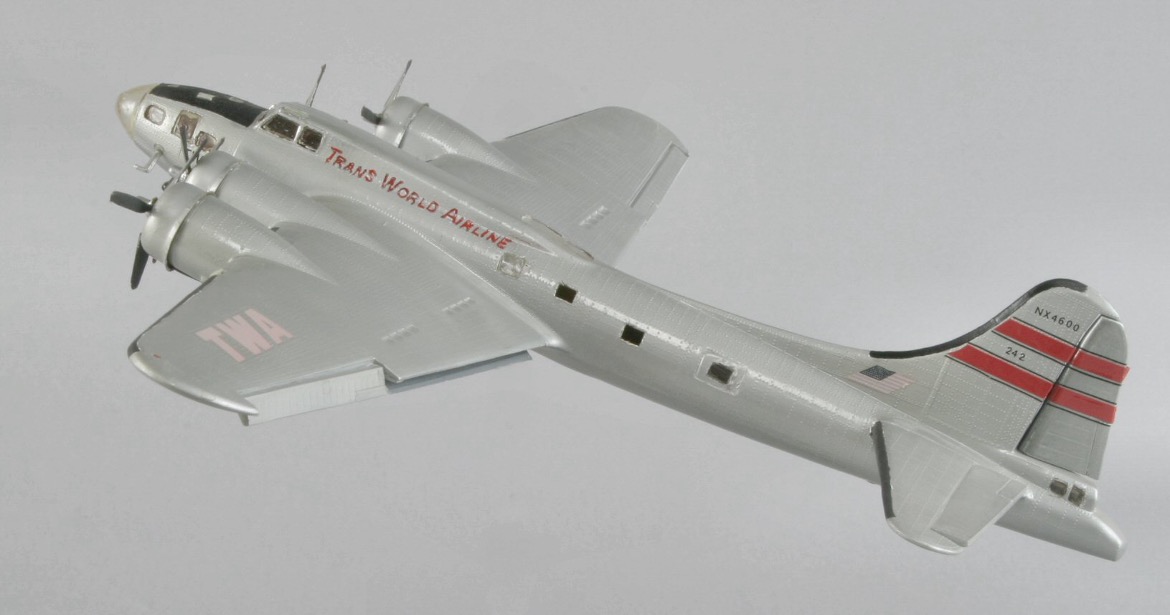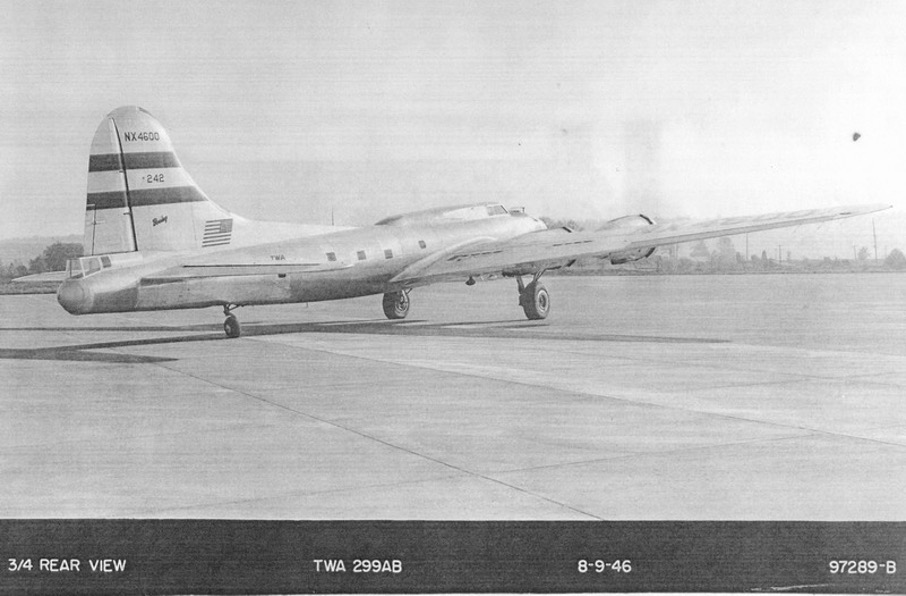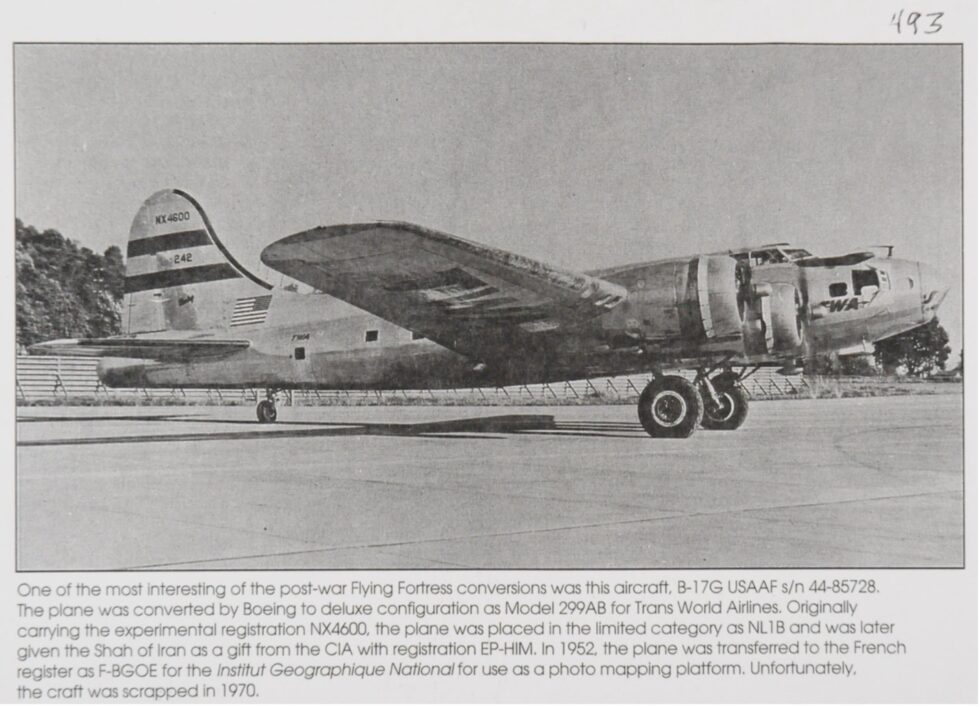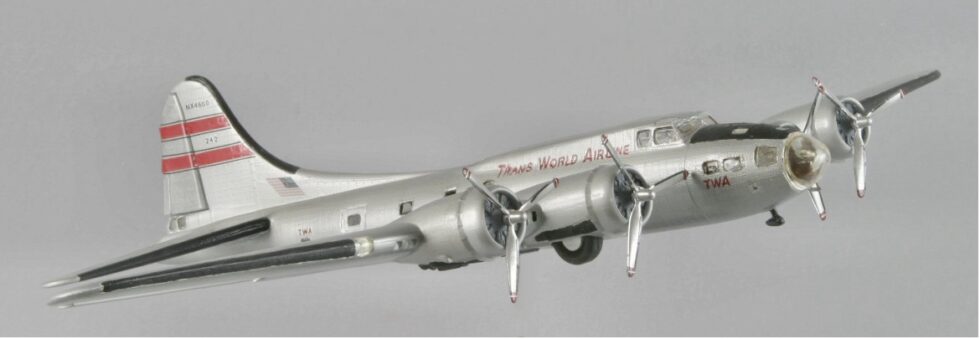TWA Boeing B-17G Flying Fortress

MODEL BY:
H. Davidson
Model Scale:
1/72
MODEL ADDED:
11/03/1978
historical significance
First Albuquerque Visit: 1946
Additional Information:
The Boeing B-17 Flying Fortress is a four-engine heavy bomber aircraft developed in the 1930s for the United States Army Air Corps (USAAC). A fast and high-flying bomber of its era, the B-17 was used primarily in the European Theater of Operations and dropped more bombs than any other aircraft during World War II. It is the third-most produced bomber of all time. The aircraft went on to serve in every World War II combat zone, and by the time production ended in May of 1945, 12,731 B-17s had been built by Boeing, Douglas, and Vega (a subsidiary of Lockheed).
TWA, which was based in New York City, began operations as Transcontinental Air Transport (TAT) on July 8, 1929 with a coast to coast route from Los Angeles to New York. Western Air Express (WAE), a competing air carrier, had begun service to Albuquerque two months earlier with a similar route from Los Angeles but their route continued on east to Amarillo, Wichita, and Kansas City. WAE was also operating other routes but due to the great depression and a ruling called the Watres Bill which involved awarding a new air mail contract that both carriers needed, TAT and the Los Angeles to Kansas City route of WAE were forced to merge. The merger took place on July 16, completed by July 24, 1930, and the one carrier became known as Transcontinental and Western Air, or “TWA”. In April 1945, a ticket office was opened in downtown Albuquerque at the Hilton Hotel which remained open through the 1970s.
The Trans World Airlines’ Executive’ Transport B-17 Flying Fortress was one of the most unique versions of the aircraft and the only B-17 to be operated by a US major airline after the war ended. Following the end of World War II in 1945, the airlines began the process of gearing up for normal civilian operations as rapid demobilization was the order of the day. One of those airlines was TWA, at the time was still known as Transcontinental & Western Airlines but would soon rename itself as Trans World Airlines.
In 1946 TWA President Jack Frye and several of his deputies visited one of the RFC (Reconstruction Finance Corporation) depots at Altus Army Air Force Base in Oklahoma to buy a low-hour B-17G Flying Fortress. Several hundred stored B-17Gs were reviewed and their log books inspected. A Vega-built B-17G, 44-85728, was selected as it had very few flight hours on it. In fact, after it was built by Lockheed Vega and delivered to the US Army Air Forces in Burbank, California, it was flown directly into storage.
The sale was finalized on 26 June 1946 and the B-17G was assigned a civilian ferry registration of NX4600 for the flight to Boeing Field in Seattle where it would get conversion work for the role for TWA’s mission to survey air routes around the world. At Boeing Field, TWA’s B-17G was quite literally taken apart as all the military items were removed and extensive soundproofing and comfortable cabin appointments were installed. Additional windows were installed in the fuselage and upgraded avionics, engines, and propellers were installed. Boeing’s designation for the B-17 was Model 299 and all the variants had a letter suffix. Since Boeing had already reached the designation Model 299Z, TWA’s custom converted B-17G became the Model 299AB. With basic TWA markings and the tail number NL1B, the airline’s B-17 would be used for long-range proving flights on prospective routes.
The TWA modifications to convert the B-17 into a VIP transport included installing a Spartan airline interior and the passenger compartment included seven airline seats, a bunk, office desk and a bathroom. There were rumors of a large overstuffed seat in the nose.
On April 1947, TWA’s luxuriously appointed B-17 was presented to the Shah of Iran and re-registered as EP-HIM and flown by TWA crews. Two years later a restructuring of Iran Air led to the B-17 being sold to the IGN (Institute Geographique National) as F-BGOE for scientific and global mapping survey flights. The IGN used the B-17 until about 1967 and it was then scrapped 1970, ending the story of one of the most unique of the B-17 Flying Fortresses.
TWA’s converted Boeing B-17G, 44-85728 transport stopped in Albuquerque New Mexico in late 1946.
GALLERY:
SEARCH OUR DATABASE:



